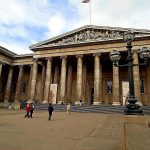Going stir-crazy in your coronavirus self-isolation? Tour these iconic museums and bucket list spots from the comfort of your couch.
Smithsonian’s National Museum of Natural History
Enjoy these self-guided, room-by-room tours of select exhibits and areas within the museum
Visitors can also access select research and collections areas at our satellite support and research stations and past exhibits no longer on display. Many of the tours provide a view of previously unseen archives or holdings.
 National Museum of Modern and Contemporary Art, Korea
National Museum of Modern and Contemporary Art, Korea
The museum’s four branches, including Gwacheon (opened in 1986), Deoksugung (opened in 1998), Seoul (opened in 2013), and Cheongju (expected to open in 2017), each in its own way, will continue to carry out MMCA’s commitment to the art and culture of Korea by enriching the first-hand cultural experience of the viewing public. Boasting a superb natural landscape surrounding the site, MMCA Gwacheon will be devoted to various genres of visual arts such as architecture, design, and crafts. Located within a historical site, MMCA Deoksugung will showcase modern art from Korea and overseas.
As China’s most famous attraction, the Great Wall of China is an essential stop on any trip to China. Commonly considered a wonder of the world, the Great Wall boasts a history of over 2,000 years and stretches more than 3,000 miles across several provinces of northern China, making it one of the most impressive ancient structures on the planet.
 National Women’s History Museum
National Women’s History Museum
It’s no secret that women run the world, and now there’s an entire museum dedicated to the hard work of our foremothers. Located in historic Alexandria, Virginia, the National Women’s History Museum was founded to integrate “women’s distinctive history and culture in the United States.” If you want to get educated and be inspired, check out their online exhibits. You can learn about everything from women in World War II to suffragettes to the rights of women throughout American history.
The virtual tour includes 360-degree panoramas of the three test areas and the surrounding landscape as well as the interiors of the test stands. The documentation focuses on six rocket test stands in the Alfa, Bravo, and Coca Test Areas. Each of the test stands are eligible for nomination to the National Register of Historic Places given their significance in the contexts of the Cold War and Space Exploration, and for their achievements in engineering and design.
 Tour of the San Diego Zoo
Tour of the San Diego Zoo
Whether it’s elephants, tigers, condors, giraffes, koala’s, apes, polar bears, penguins, baboons or panda’s, there’s a camera feed you can watch.
The Uffizi was designed by Giorgio Vasari in 1560 for Cosimo I de’Medici to house the Granducal Magistratures of Tuscany. In 1565, on the occasion of the marriage of his son Francesco to Giovanna d’Austria, Cosimo I asked Vasari to design a raised passageway connecting Palazzo Vecchio with Palazzo Pitti, the new residence of the family. The passage starts from the government palace, Palazzo Vecchio, goes through the Uffizi, then runs parallel to the river above a portico and crosses over the Ponte Vecchio. The Corridor continues through the facade of the church of Santa Felicita to reach the Boboli Gardens.
 British Museum, London
British Museum, London
This iconic museum located in the heart of London allows virtual visitors to tour the Great Court and discover the ancient Rosetta Stone and Egyptian mummies. National museum with particularly outstanding holdings in archaeology and ethnography. It is located in the Bloomsbury district of the borough of Camden. Established by act of Parliament in 1753, the museum was originally based on three collections: those of Sir Hans Sloane; Robert Harley, 1st earl of Oxford; and Sir Robert Cotton. The collections (which also included a significant number of manuscripts and other library materials) were housed in Montagu House, Great Russell Street, and were opened to the public in 1759.
The Louvre ceased to be a royal residence when Louis XIV moved his court to Versailles in 1682. The idea of using the Louvre as a public museum originated in the 18th century. The comte d’Angiviller helped build and plan the Grande Galerie and continued to acquire major works of art. In 1793 the revolutionary government opened to the public the Musée Central des Arts in the Grande Galerie. Under Napoleon the Cour Carrée and a wing on the north along the rue de Rivoli were begun. In the 19th century two major wings, their galleries and pavilions extending west, were completed, and Napoleon III was responsible for the exhibition that opened them. The completed Louvre was a vast complex of buildings forming two main quadrilaterals and enclosing two large courtyards.
 Great Wall of China
Great Wall of China NASA Space Center
NASA Space Center Van Gogh Museum Amsterdam, Netherlands
Van Gogh Museum Amsterdam, Netherlands Uffizi Gallery, Florence
Uffizi Gallery, Florence Louvre Museum | Paris
Louvre Museum | Paris
